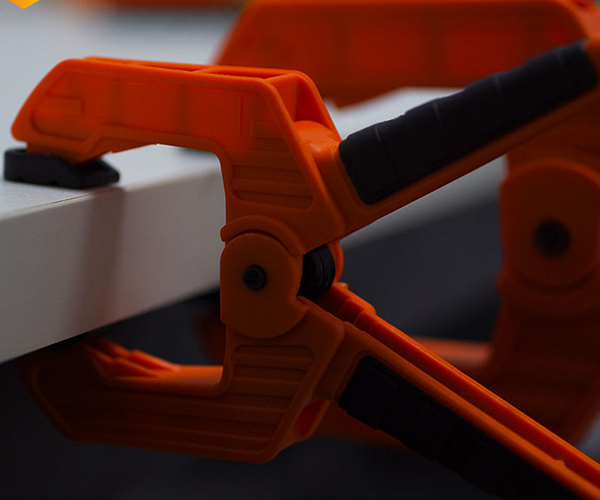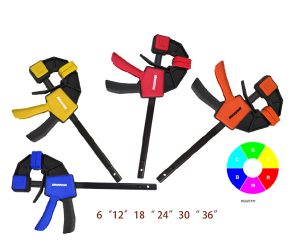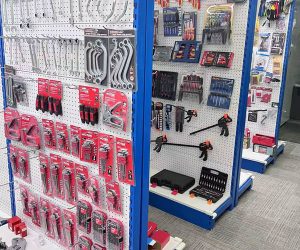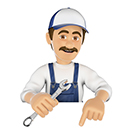A spring clamp is a versatile and indispensable tool used in various industries, from woodworking to car repairs. But what exactly is a spring clamp, and how does it stand out from other types of clamps? In this article, we will explore the definition, mechanism, benefits, types, applications, and more about spring clamps. Whether you are a DIY enthusiast, a professional craftsman, or an engineer, understanding the practical uses of a spring clamp can help improve your productivity and the quality of your work.
1. What Is a Spring Clamp?
A spring clamp is a hand tool designed to hold objects together using spring tension. These clamps are widely used in workshops, garages, and industrial settings due to their ability to apply constant pressure to materials, ensuring they stay in place while work is being done. They are often made of metal with a spring mechanism, offering quick and easy adjustments to fit various sizes of objects.
What’s the real story here? Unlike traditional C-clamps or bar clamps, spring clamps are small, lightweight, and easy to use with one hand, which makes them ideal for quick and temporary holds. This makes them perfect for tasks like holding pieces of wood in place during woodworking, clamping car parts during repairs, or even keeping papers together in an office setting.
Table: Types of Spring Clamps
| Type of Clamp | Size Range | Typical Applications | Advantages |
|---|---|---|---|
| Small Spring Clamp | 1 to 4 inches | Woodworking, Crafts | Lightweight, Easy to use |
| Medium Spring Clamp | 4 to 8 inches | DIY projects, General clamping | Versatile, Adjustable pressure |
| Large Spring Clamp | 8 to 12 inches | Heavy-duty work, Automotive repairs | Strong grip, High durability |
2. How Does a Spring Clamp Work?
The operation of a spring clamp is straightforward, but it’s important to understand how its mechanism works to use it effectively. The clamp consists of two jaws, which open and close when you squeeze the handle. The handle is connected to a spring that provides constant tension, allowing the clamp to hold onto objects firmly. The more pressure you apply to the handle, the stronger the grip becomes.
Ready for the good part? The real advantage of spring clamps is their ability to hold objects without needing to constantly adjust or tighten screws like with other types of clamps. The spring keeps the jaws closed, and the clamp’s design ensures a consistent hold, reducing the risk of slipping or losing grip during work.
Table: Spring Clamp Mechanism
| Component | Description | Function |
|---|---|---|
| Jaws | Two gripping surfaces | Apply pressure to materials |
| Spring | A coiled metal component | Provides tension and keeps jaws closed |
| Handles | Ergonomically designed grips | Allows users to easily apply force |
3. What Are the Benefits of Using a Spring Clamp?
Spring clamps offer several advantages that make them a must-have in any toolkit. One of the key benefits is the simplicity and ease of use. Unlike other clamps that require you to tighten bolts or screws, spring clamps are ready to go with a simple squeeze of the handles. This makes them ideal for situations where you need a quick, temporary hold.
What’s the kicker here? The convenience doesn’t stop there. Spring clamps also offer a lot of versatility. They can be used for a wide range of tasks, from light-duty clamping to heavy-duty applications. Plus, their lightweight nature means they’re easy to transport, making them great for mobile workstations or on-the-go projects.
Table: Advantages of Using a Spring Clamp
| Advantage | Explanation |
|---|---|
| Ease of Use | Simply squeeze the handle to apply pressure |
| Versatility | Works across various tasks and materials |
| Lightweight | Easy to carry and maneuver |
| Time-Efficiency | Quick and easy to use, reducing setup time |
4. What Are the Different Types of Spring Clamps?
Spring clamps come in different sizes and designs to suit various tasks. From small clamps that are perfect for lightweight materials to large ones used for heavy-duty applications, each type has its place in a toolbox. But here’s the interesting part—spring clamps are also made from different materials, such as plastic, steel, and even stainless steel, depending on the type of job they are meant to handle.
Ready for the good part? For instance, small spring clamps are often used in crafting and light-duty tasks, while larger versions are built for holding larger materials or more substantial clamping force needed in industrial applications. Choosing the right size and material ensures better performance and longer tool life.
Table: Types of Spring Clamps and Their Applications
| Clamp Size | Common Material | Typical Use Case |
|---|---|---|
| Small Spring Clamp | Plastic or Metal | Crafts, Office, Light DIY |
| Medium Spring Clamp | Plastic or Steel | Woodworking, General Use |
| Large Spring Clamp | Steel or Stainless | Heavy-duty Work, Automotive Repairs |

5. Where Are Spring Clamps Typically Used?
Spring clamps are used across a wide range of industries and settings. In woodworking, they are essential for holding pieces of wood together while being glued or nailed. Similarly, in automotive repairs, spring clamps can hold parts in place while you work on them. These clamps are also frequently used in home improvement projects, such as securing materials while painting or during minor repairs.
What’s the real story here? Their applications aren’t just limited to professional settings. Spring clamps are often found in the home as well, holding fabric in place for sewing projects or even as a temporary method for securing pipes during installation. The versatility of spring clamps makes them one of the most common tools for any task that requires a firm, temporary hold.
Table: Common Uses of Spring Clamps
| Use Case | Industry/Application | Example of Use |
|---|---|---|
| Woodworking | DIY, Professional | Holding wood pieces for gluing |
| Automotive Repairs | Automotive | Securing parts during car repairs |
| Home Improvement | DIY, Home projects | Clamping materials for painting |
6. How Do You Choose the Right Spring Clamp?
Choosing the right spring clamp depends on several factors, such as the material you are working with, the weight of the objects, and the type of work you’re doing. For light tasks, a small plastic clamp might suffice, while larger, heavy-duty tasks require a strong metal clamp.
But wait, there’s more! It’s not just about size and strength. The handle design is also important—look for ergonomic handles that provide comfort during prolonged use, especially if you’ll be applying force repeatedly. Additionally, consider the jaw material and the amount of pressure you need for your project.
Table: Choosing the Right Spring Clamp
| Factor | Considerations |
|---|---|
| Size | Small, medium, or large based on material |
| Material | Plastic, steel, or stainless steel |
| Handle Design | Ergonomic handles for comfort |
| Pressure Capacity | Choose based on the material and task at hand |
7. What Are the Key Features of a Spring Clamp?
The main features of a spring clamp include its adjustable pressure, ease of use, and durable materials. One of the standout features is the strong spring mechanism that ensures the clamp holds its grip until the user decides to release it. In addition, many spring clamps come with padded or coated jaws to protect delicate surfaces from damage.
This is where it gets interesting! Some clamps even feature a quick-release mechanism for easier detachment, which comes in handy when you need to quickly move to the next step in your project. Whether for light-duty or heavy-duty tasks, the versatility of spring clamps continues to impress.
Table: Key Features of Spring Clamps
| Feature | Description |
|---|---|
| Adjustable Pressure | Provides a range of holding force |
| Ergonomic Handles | Easy to hold and apply pressure |
| Padded Jaws | Protects sensitive surfaces from damage |
| Quick-Release Mechanism | Allows for fast detachment when needed |
8. Can Spring Clamps Be Used for Heavy Duty Tasks?
While spring clamps are incredibly versatile, it’s important to know their limits, especially when it comes to heavy-duty tasks. These clamps are great for holding materials together during light and medium-duty applications, but when you move on to large, heavy-duty projects, you’ll need to consider the size and strength of the clamp.
But here’s the kicker: Even though spring clamps can be used for some heavy-duty tasks, they do have limitations. The pressure they apply is often not as adjustable or powerful as other types of clamps, such as bar clamps or C-clamps. For example, when you’re working with thick, dense materials or performing tasks that require substantial clamping pressure (such as heavy welding or clamping metal parts), a spring clamp might not provide the necessary hold.
However, when used properly for tasks within their weight range, spring clamps can offer a very strong grip, especially if you choose large-sized clamps made from materials like stainless steel. So, it’s all about knowing when to switch up your tools to get the job done right.
Table: Heavy-Duty Uses of Spring Clamps
| Task | Recommended Clamp Size | Material |
|---|---|---|
| Woodworking (Large boards) | Large Spring Clamp | Steel or Stainless |
| Automotive Repairs | Large Spring Clamp | Stainless Steel |
| Industrial Equipment | Large Spring Clamp | Heavy-Duty Steel |
9. How Do You Maintain a Spring Clamp?
To ensure your spring clamp lasts for years and performs at its best, proper maintenance is key. Just like any tool, if you neglect regular care, its performance can degrade over time. But here’s the good news—maintaining a spring clamp is relatively easy.
Start by cleaning the clamp regularly to remove dust, dirt, and grime that can cause the mechanism to stick or wear out. For metal clamps, wipe them down with a cloth, and for those with rubber or plastic jaws, be sure to check that the pads are intact and not peeling off. If you use the clamp outdoors or in humid environments, it’s a good idea to apply a light coat of oil to the spring mechanism to prevent rust.
Another important step in maintenance is inspecting the spring clamp’s integrity. Look for signs of wear, such as cracks in the handles, warping of the jaw, or a loss of tension in the spring. Replacing broken parts or buying a new clamp when necessary will ensure you always have a reliable tool when you need it.
Table: Spring Clamp Maintenance Checklist
| Maintenance Task | Frequency | Tool Used |
|---|---|---|
| Clean and remove debris | After each use | Cloth, Water |
| Lubricate spring | Every 6 months | Light lubricant |
| Inspect for wear | Annually | Visual inspection |
10. What Safety Precautions Should You Take When Using a Spring Clamp?
While spring clamps are easy to use and efficient, safety should always be a top priority. The spring mechanism can exert a lot of pressure, and improper use can lead to injuries, especially if the clamp slips or the material you are holding moves unexpectedly. But here’s the thing: With a few simple precautions, you can minimize the risk and ensure that your work is done safely.
First, always wear safety glasses or goggles when working with spring clamps. The spring can snap or cause debris to fly off, so it’s better to be safe than sorry. Additionally, be cautious when releasing the clamp—do not let go abruptly. The sudden release of tension can cause the clamp to shoot out or cause injury to your hands.
What’s the real story here? Always make sure your hands are clear of the clamp’s jaws when applying pressure. Keeping a firm grip on the handles and maintaining control is essential for preventing accidents. Lastly, if you’re working with delicate or fragile materials, use spring clamps that have padded or coated jaws to avoid damaging the surface.
Table: Safety Precautions for Using Spring Clamps
| Precaution | Why It’s Important |
|---|---|
| Wear safety glasses | Protects eyes from debris or snapping clamps |
| Maintain a firm grip | Prevents slipping or unexpected clamp release |
| Use padded jaws for delicate materials | Prevents damage to surfaces |
11. What Are the Alternatives to Spring Clamps?
While spring clamps are an excellent choice for many tasks, there are several alternatives that may better suit your needs depending on the project. If you require a more adjustable or powerful clamp, you may want to consider alternatives like C-clamps or bar clamps. These types of clamps are designed to provide more pressure, which makes them ideal for holding large or heavy materials in place.
But here’s the kicker: The versatility of spring clamps still puts them ahead for smaller, quick jobs. For instance, when you’re holding materials for painting or making small woodworking repairs, a spring clamp is ideal due to its lightness and ease of use. But when you need to apply more pressure to hold materials firmly over a long period, it’s time to consider clamps that offer more strength, such as C-clamps or even pneumatic clamps for professional applications.
Table: Clamp Alternatives for Various Projects
| Clamp Type | Best For | Advantages |
|---|---|---|
| C-Clamps | Holding larger materials in place | More powerful hold, adjustable pressure |
| Bar Clamps | Woodworking, large-scale projects | Strong grip, adjustable reach |
| Pneumatic Clamps | Industrial work, heavy-duty clamping | Maximum pressure, easy to use hands-free |
12. How Do Spring Clamps Compare to Other Clamps?
Spring clamps stand out for their quick and easy application. But how do they compare to other clamp types? To answer this question, we’ll look at the key differences between spring clamps and other commonly used clamps, such as bar clamps, C-clamps, and pipe clamps.
What’s the real story? While spring clamps are lightweight and easy to use for a wide range of applications, they aren’t as powerful as some of the larger, more robust clamps. For example, C-clamps offer more torque and stability when working with heavier materials, while bar clamps can hold larger pieces of wood or metal more securely for longer periods of time.
However, spring clamps are excellent when you need a fast and easy solution for temporary clamping or light-to-medium tasks. They provide just enough pressure to secure most materials and are perfect for quick fixes.
Table: Comparison of Spring Clamps vs Other Clamps
| Clamp Type | Pressure Capacity | Ideal Use Case |
|---|---|---|
| Spring Clamps | Light to Medium | Quick, temporary clamping |
| C-Clamps | Heavy Duty | Large or heavy materials, stable hold |
| Bar Clamps | Medium to Heavy | Woodworking, large pieces of material |
| Pipe Clamps | Heavy Duty | Plumbing, pipe fittings |
13. What Are Some Creative Ways to Use a Spring Clamp?
Spring clamps are incredibly versatile, and while they are most commonly used for woodworking or automotive tasks, there are plenty of creative ways to utilize them. From DIY projects to crafts, spring clamps can be used for almost any task that requires temporary holding or securing of materials.
Ready for the good part? You can use spring clamps to hold materials together for sewing projects, secure pieces of fabric for painting, or even stabilize wires when doing electrical work. Because they are lightweight, they are perfect for small crafting tasks where you need a steady hand, like creating custom picture frames or assembling models.
Table: Creative Uses for Spring Clamps
| Creative Use | Application |
|---|---|
| Crafting | Holding fabric, sewing materials |
| Electrical Work | Stabilizing wires |
| Painting | Securing canvas or paper |

14. What Are the Limitations of Spring Clamps?
Despite their many benefits, spring clamps do have limitations that are important to consider. While they are incredibly useful for light and medium-duty tasks, they aren’t suitable for tasks requiring high pressure or long-term holding. They also tend to lose their effectiveness when dealing with thicker or tougher materials.
What’s the kicker here? The main limitation of spring clamps lies in their pressure capacity. If you need a clamp that can handle extreme force or hold large items in place for an extended period, spring clamps might not be the best option. Instead, consider opting for a more powerful type of clamp designed specifically for heavy-duty applications.
Table: Limitations of Spring Clamps
| Limitation | Reason |
|---|---|
| Low Pressure Capacity | Not suitable for large, heavy materials |
| Short-Term Hold | Cannot hold materials for long periods of time |
| Limited Size Range | Not ideal for clamping large, bulky materials |
15. How Can You Use Spring Clamps to Improve Your Projects?
Spring clamps can significantly improve your projects by offering a simple, efficient solution for holding materials together while you work. Whether you’re working in a workshop or on a DIY project, these clamps provide quick fixes and enable you to focus on the more critical aspects of the task.
But here’s the kicker: Spring clamps are ideal for boosting your productivity. With easy application and the ability to quickly hold materials in place, you can complete your projects faster and more efficiently. Plus, their lightweight and portable design makes them perfect for both at-home use and in professional settings.
Table: How Spring Clamps Improve Project Efficiency
| Benefit | Impact on Productivity |
|---|---|
| Quick Setup | Reduces time spent on preparation |
| Easy Adjustment | Allows for faster changes during the task |
| Lightweight | Makes handling and moving materials easier |
FAQ
Q1: What is a spring clamp?
A spring clamp is a tool that uses a spring mechanism to apply constant pressure to hold materials together, providing a secure temporary hold.
Q2: How does a spring clamp work?
A spring clamp works by squeezing the handles to open the jaws, with the spring providing the force needed to keep them closed.
Q3: What are the different types of spring clamps?
Spring clamps come in small, medium, and large sizes, each suited to different tasks ranging from light DIY projects to heavy-duty repairs.
Q4: Can spring clamps be used for heavy-duty tasks?
Spring clamps can handle moderate tasks but may not be strong enough for large, heavy-duty materials. For more force, a bar clamp or C-clamp is better suited.
Q5: How do you maintain a spring clamp?
Maintaining a spring clamp involves cleaning, lubricating the spring, and inspecting for damage to ensure the clamp functions effectively.





